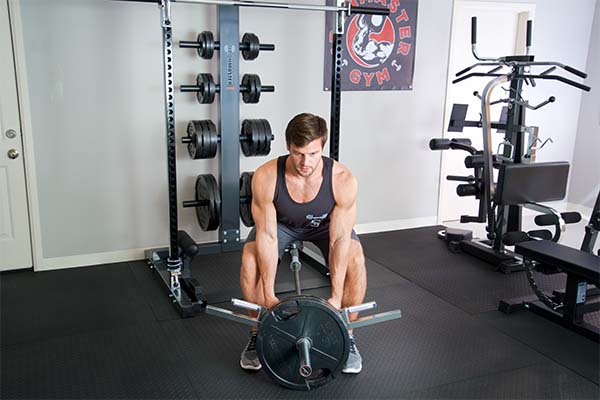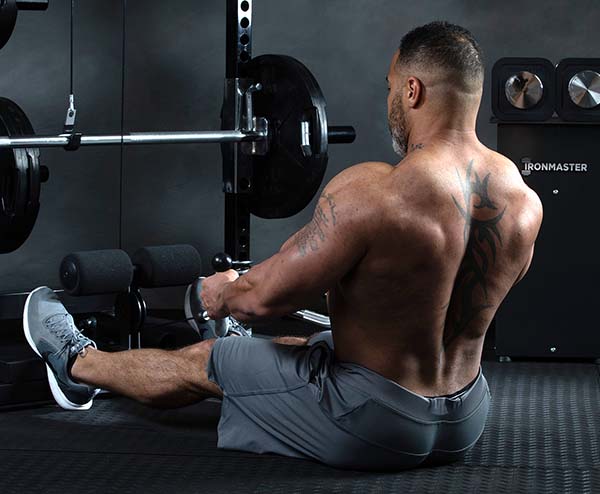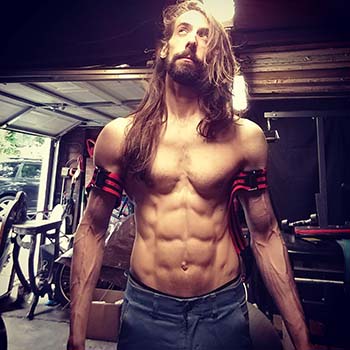Blog
You Need a Strong Upper Back
Why building a bigger back will help build your entire body.
You Need a Strong Upper Back,
Even if You’re Not a Bodybuilder
Let’s face it: Having a big, strong, muscular upper back is impressive. It just looks powerful, basically. A lot of people think the importance of a well-developed back ends in the realm of the aesthetic. “I’m not a bodybuilder. I just want a heavy squat, bench, and deadlift. So, why bother building the back in isolation?”
In this article, I’m going to demonstrate how building your upper back *will* help you build a stronger chest, legs, and everything else by improving your strength and performance in the Big Three.
And, if you are a bodybuilder, all of this will allow you to get much bigger as well.
The Upper Back in the Bench Press
Here are a couple of major ways the upper back helps the bench press.
The first is stability. A bigger back creates a wider and thicker foundation upon which to press bigger, heavier weight.
The second is injury prevention. When you allow your shoulders to creep up and forward during pressing, excessive elbow flaring is often the result. This causes undue shoulder stress because of the way the tendons of the shoulder interact with the shoulder joint, as Mark Rippetoe describes in “Starting Strength.” 1
By keeping your shoulders pulled back and down (i.e. “retracted” and “depressed”), you greatly reduce this injury risk. Your benching muscles (pecs, triceps, and front deltoids) also receive a deeper stretch at the bottom of the press, thereby resulting in better stimulation of the muscles you’re trying to build.

Training the Upper Back for the Bench Press
For a stronger bench press, rows are your best friend.
Unless you can’t perform barbell or other unsupported rows due to injury, cable or machine rows shouldn’t be your main row styles. (If that is the case, though, don’t worry; you’ll be 100% fine).
Instead, focus primarily on building your Barbell Rows, including the standard Bent-Over, as well as the many Barbell Row variations available, such as the Snatch-Grip, Yates, and Pendlay Rows.
The T-Bar Row and its variations, such as the Supported T-Bar, Wide-Grip, Narrow-Grip, Meadows Row, and many others, are excellent options. The T-Bar Row is also great because it can be easier on the lower back. Why? Because you can get a good horizontal pulling movement while remaining more upright.
The Upper Back for Squatting
The upper back is integral to maximal squat development for three main reasons. The first is somewhat obvious.
When you’re performing a back squat, what is the bar resting on? Your upper back. Whether you’re squatting high-bar (bar on upper traps) or low-bar (bar on rear deltoids), upper back strength is easily the limiting factor when it comes to pushing your squat to higher and higher numbers.
The second reason is, again, injury prevention. If your upper body rolls forward--shoulders collapse, elbows tuck under, et cetera--injuries of the knees are common as your entire body lurches and falls forward unwittingly. Doesn’t sound fun, does it?
The third reason relates to giving yourself a mechanical advantage: the thicker your back, the farther *back* the bar can go (not down, but back, as Louie Simmons points out in his “Westside Book of Methods”2), thereby making it easier to keep the bar over the midfoot (midfoot is midway from the back of the heel to the tip of your big toe), which is where it should be no matter what style you’re squatting with for maximal strength.

Training the Upper Back for Squatting
No matter how you squat, the two main areas you want to focus on are the trapezius and the rear deltoids.
For the rear delt, you want to focus on row variations in which the elbow is either very flared away from the body or very tucked to the side. So, for flared: Snatch-Grip, Wide T-bar, or Wide-Handle Cable Rows. For tucked row styles: Yates, Close-Grip T-Bar, or Neutral-Grip Cable Rows are perfect. All of these will conveniently develop the traps, as well.
The Face Pull is an amazing exercise for building the rear delt, as is the oft-overlooked Lying Side Raise, favored by classic bodybuilders like Serge Nubret for its ability to pummel the rear delt into submission.
And, the Reverse Fly is a useful option for building the rear delts.
For the traps, use Above-the-Knee Rack Pulls (a type of deadlift with a very short range of motion), Shrugs, Farmer’s walks, and Dumbbell Upright Rows. To build the mid/lower traps, use the Reverse Shrug. Also, if you do any type of pullup or pulldown, remember to push the shoulder DOWN at the bottom of each rep. This helps produce a thicker mid-upper-back, filling the gap between the shoulder blades.
The Upper Back in Deadlifting
A stronger upper back provides more stiffness during the deadlift. Similar to a squat, a weak upper back can result in forward movement at the upper and lower back which can limit strength and lead to injury.
Additionally, rowing (when done correctly) builds the external rotators of the shoulder, which are responsible for pulling you into the correct position and engaging the lats during the deadlift. This is also important as it shortens the distance the weight is moved as seen when performing a proper deadlift.
And what else do rowing and pull-up build? The lats themselves! Stronger lats = more tightness and stability = a stronger deadlift.
On top of that, rows and pullups build grip strength. If your upper back is not the limiting factor in your deadlift, your grip may very well be. Scrap the straps and mixed grip for as long as you can, keep it simple, and just build some good grip strength!
Training the Upper Back for Deadlifting
For deadlifting, plenty of rows are always helpful, but pull-ups with an outside-shoulder-width grip are also fantastic. This is because a wider grip uses shoulder adduction (pulling your elbows into your sides) to build your back, whereas rows generally work the back through shoulder extension (pulling your elbows behind you). Strengthening the back in multiple movement patterns leads to a stronger, thicker, wider lat muscle that is able to remain stable and tight during stupid-heavy deadlifts.
All of the aforementioned row styles help build the deadlift, so I won’t mention them again. Regarding pull-up variations, any pull-up or pull-down with a grip that is outside shoulder width can do the trick. And don’t forget: if it gets too easy, add weight.
Speaking of weight, when it comes to pull-downs, don’t go too light. Build up some fatigue, get some mind-muscle connection, and put the work in. You’re not just trying to fluff the muscle-up; you’re trying to make it stronger. I mean, what are we; bodybuilders?
How to Organize and Structure Upper Back Training
You should work your upper back at least twice a week, or at every workout. Do at least some of your back work before your main press, squat, or deadlift. And if your back is especially lagging, do a “back phase,” as advised by the late, great John Meadows (who invented the Meadows Row). Emphasize back training in your program for a specific length of time--Four weeks, for example.
A few things to keep in mind:
Rows: at a certain point, cheating becomes inevitable. Be honest with yourself and don’t get injured. Avoid doing sets of less than 5. You should employ diaphragmatic breathing techniques early on to avoid injury.
Pull-ups: eventually, you will need to perform them multiple times per week to see progress. Pull-downs can help, but make sure to go heavy enough.
Rear Delts: Using the Reverse Pec Deck Fly is cool, and may be adequate for some people, but don’t rely on it.
Special trapezius work can be minimally done 2-4 times per month. The rest of your pulls, deadlifts, and squats, plus any overhead press work, will take care of it. But feel free to go crazy.
On any pull or shrug, when grip becomes an issue, use straps, but keep training your grip.
One Quick Note and Conclusion
Maximum strength on the squat, bench, and deadlift can’t be built by doing these lifts alone, but, this is not an excuse to overlook them. You still need to do them regularly in order to achieve adequate proficiency at them. Without proficiency, it doesn’t matter how strong your upper back is; you will never come anywhere close to your potential, let alone reach it.
If you never get lazy with your upper back training, you can expect better squats, benches, and deadlifts from here on out, not to mention better posture and a more impressive-looking physique. Not that you’re a bodybuilder or anything! Happy pulling!

About the author
Mark Ludas CPT is a NASM-certified personal trainer with a decade of experience in the fitness industry. After an asthmatic childhood, Mark discovered his natural aptitude for fitness in his late twenties. At age 36, he accomplished a 300+ pound conventional deadlift and 280+ high-bar squat as a 6’5” 170-pound ectomorph on a fully vegan diet, all after just one year of proper self-programming. Mark is the founder of Resistance Quest Fitness, established in 2016, and the creator of the Paralinear Method of strength training. Additionally, he is a writer, actor, model, and musician. Find him on Instagram, Facebook, Youtube, and at www.resistancequest.com.

150 Comments